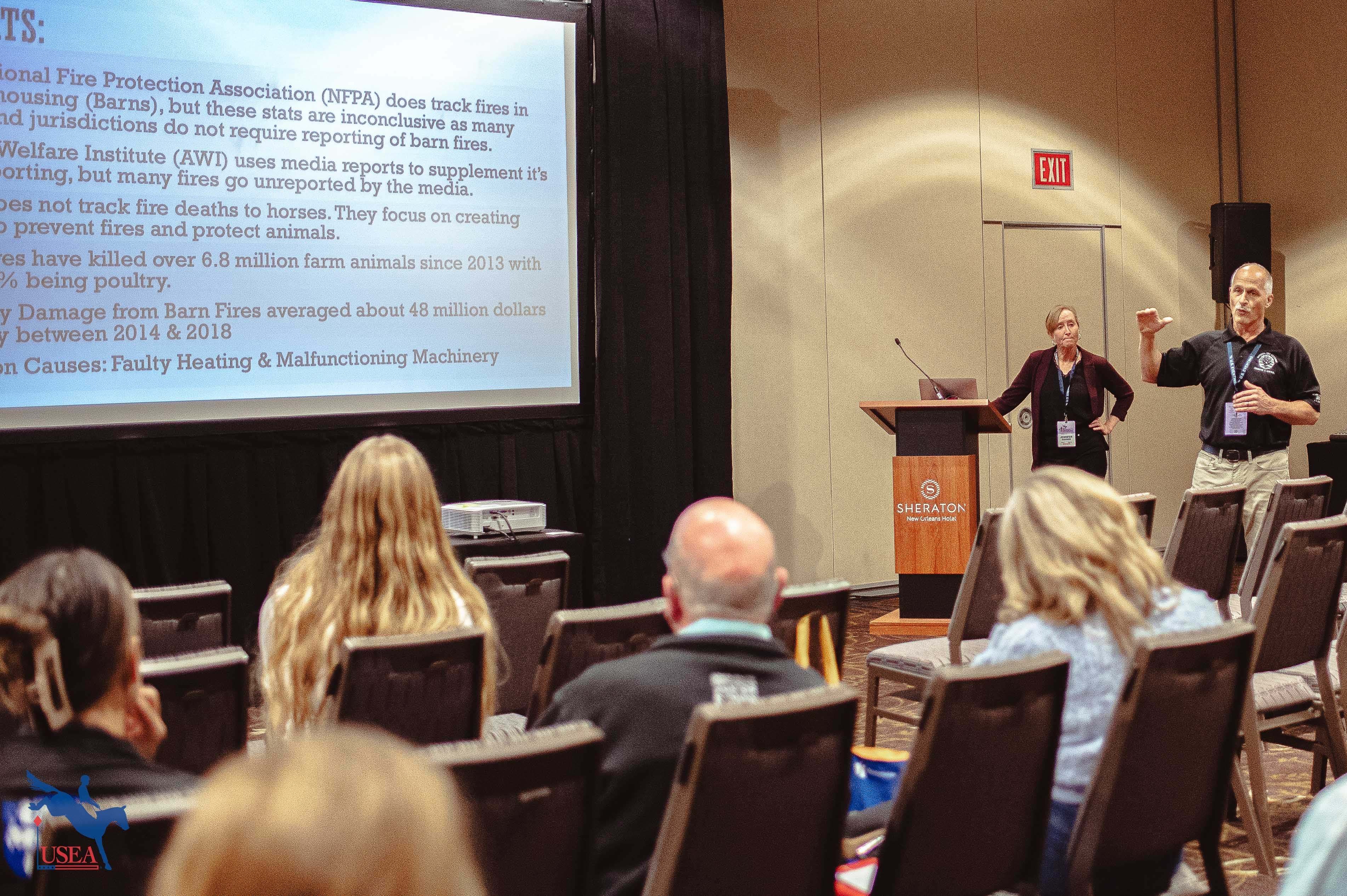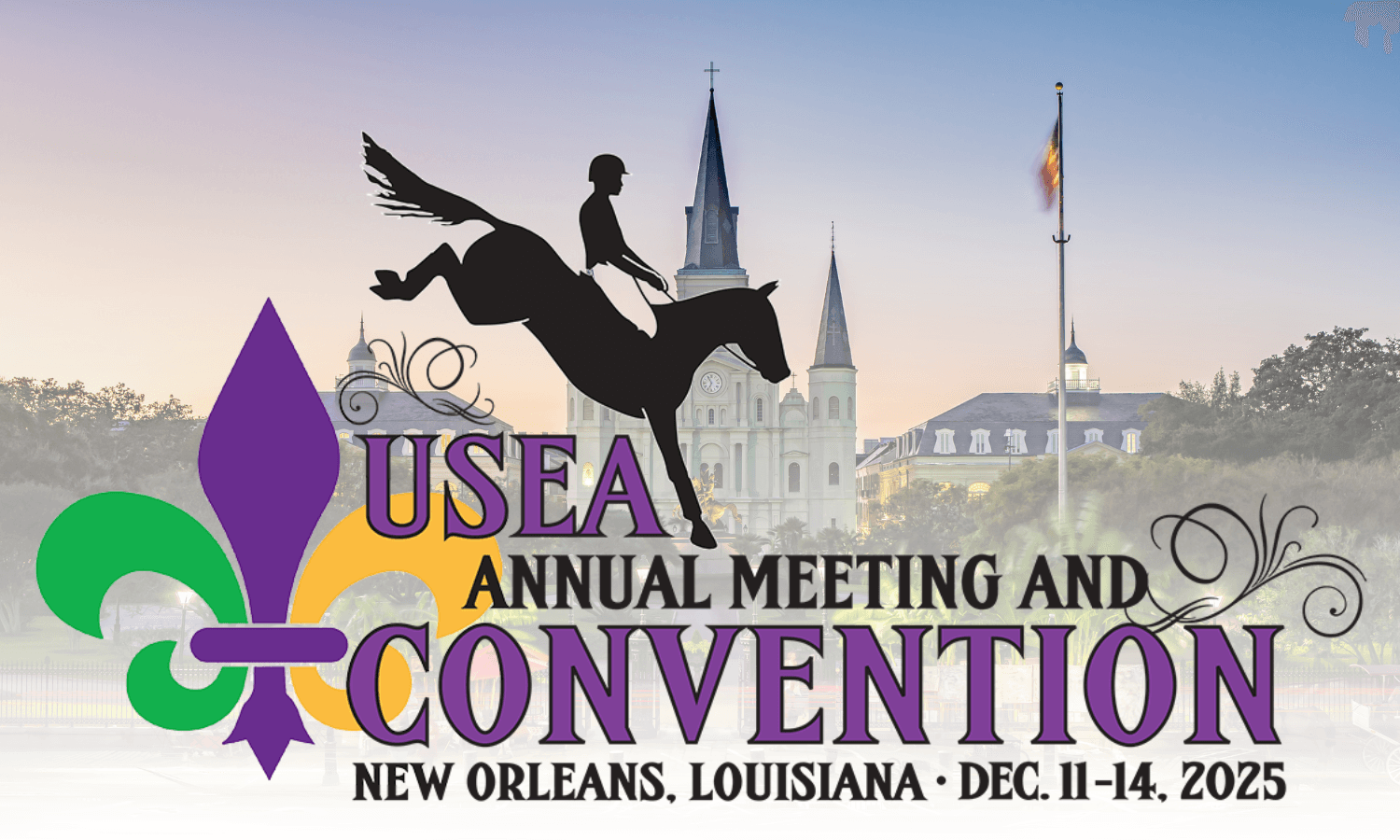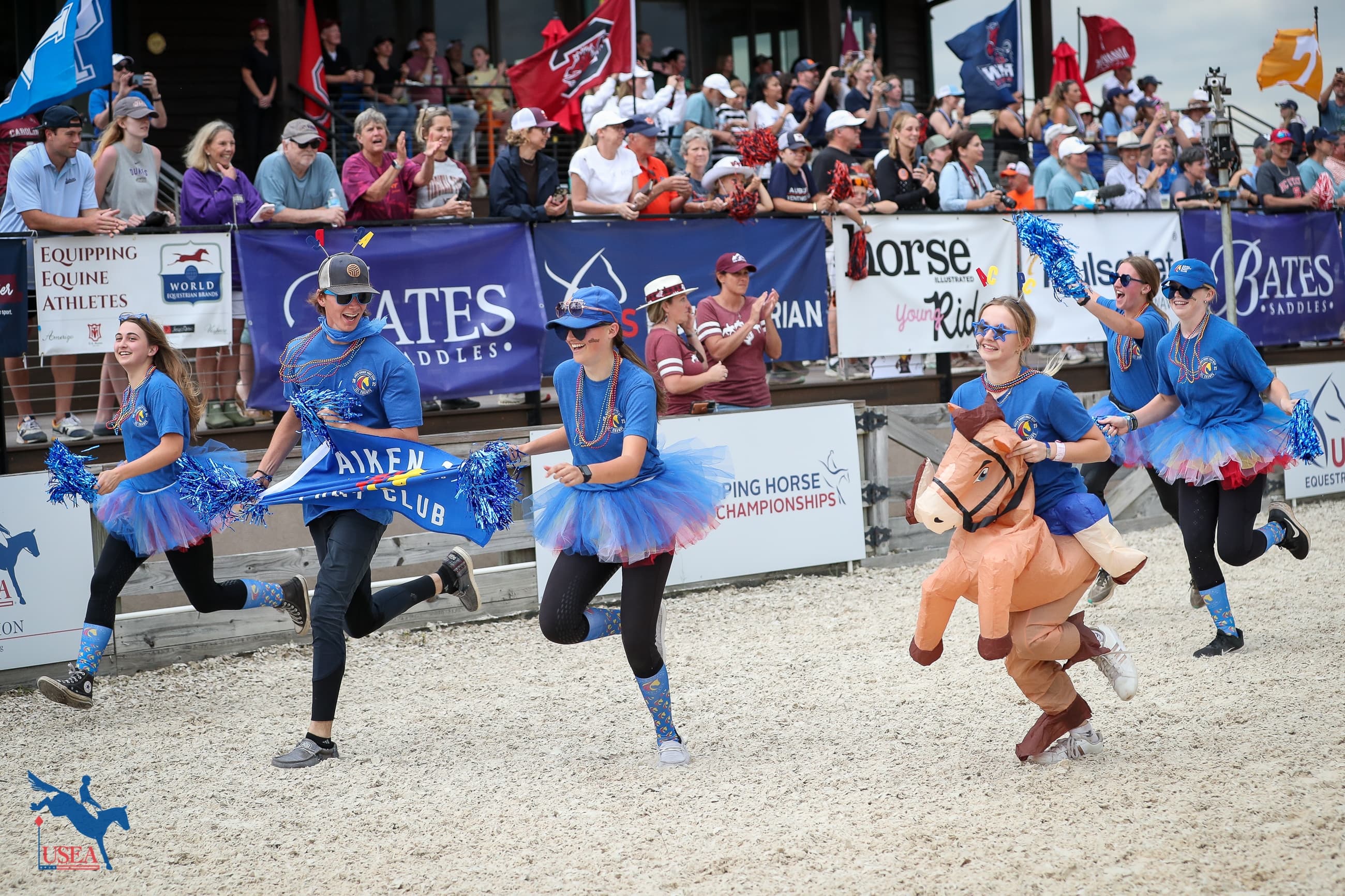Eventing Community Shares Input and Opinions During Event Riders and Officials Town Hall

At the end of a busy and educational day on Friday during the 2022 USEA Annual Meeting & Convention, riders, owners, officials, and eventing enthusiasts gathered for one of the highlights of the day’s schedule, the Event Riders and Officials Town Hall. Moderated by former USEA President Kevin Baumgardner, the Town Hall featured a panel made up of Eventing Riders Association of North America (ERAofNA) representatives Shannon Lilley and Lauren Nicholson, USEA President Max Corcoran, and USEA Eventing Licensed Official Committee (ELOC) representatives Tim Murray and Cindy Deporter.
Baumgardner started the meeting by outlining the objectives of the evening’s open forum which included improving communication between riders and officials, understanding measures that riders can take with concerns about officials, outlining what a safe show jumping warm-up might look like, and how social media can impact our sport/proper use of social media. The topic of yellow cards was also on the evening’s agenda, but the forum reached its time limit before the panel could address the final discussion point.
Communication Avenues and Opportunities for Improvements
Communication between riders and officials was the first talking point and was the most discussed agenda item of the evening, taking up almost a full hour of the hour-and-a-half schedule block. Official communication options were outlined such as speaking with the athlete representative, Technical Delegate (TD), and organizer, filing a protest or appeal and submitting a confidential evaluation of officials to the United States Equestrian Federation (USEF).
There was much discussion surrounding the licensed official evaluations. Evaluations can be positive or negative. Murray explained that currently, those forms are submitted confidentially to the USEF Licensed Officials Committee (LOC) where each one is reviewed. Every official for whom an official evaluation is submitted receives a summary of that evaluation within a few weeks of its submission and will be asked to respond. The rider’s name is withheld from these reports, but in specific cases, the details surrounding the instance might make it easy to identify who the reporting rider might have been. In terms of determining if there are large issues to be addressed, the LOC looks at the frequency in which the evaluations are received and the number of evaluations against one individual official.
Concerns were raised regarding what actually comes from the evaluations and whether or not those actions were communicated back to the reporting rider and the general public. Alina Brazzil, the USEF Director of Licensed Officials, responded, “These actions are not printed in the back of the [USEF] magazine. I fully understand the feeling of the dark of not knowing what happens, it has been on my list to investigate how we can provide more communication back to the reporting party or if there is another avenue for that.”
“It is not fair that it is published [in the back of the magazine] when a rider receives a yellow card, but disciplinary actions issued against officials are not treated equally,” Nicholson commented. "From our perspective, nothing happens after we file that evaluation. All we know is that nothing has ever come from it, so it is very frustrating."
Lilley also chimed in, “We want to create a positive atmosphere between officials and riders. If the system isn't working, it’s a failed system. We have to see if we have the correct systems in place and how we can improve them and be better at all things. It is nice to have these conversations because a lot of us don't know where these things go, but it seems like the communication and transparency can be better.”
Professional rider and 2022 Bates USEA Lady Rider of the Year Tamra Smith spoke up from the audience. “I feel like the biggest thing is getting the riders and officials of the event going in a more cohesive, forward, positive manner. When we as riders put in an inquiry or complaint or something, we want some follow-up. If that same thing happened with a rider, we would be reprimanded and get a yellow card or something official would happen and everyone would know about it. When an official does something that isn't the right call and nothing is made right, nothing happens from what the riders feel. When a rider breaks a rule, it is our responsibility to know the rule and we get reprimanded. When an official doesn’t follow a rule, it feels like, ‘sorry we did the best we can.’ That is difficult. It all ends up on the rider's back. The mistake the official makes ends up on the rider’s back. That is where the frustration ultimately is, how do we fix that?”
An incident that took place with an international rider during ring familiarization of the CCI5*-L at the Maryland 5 Star in October of 2022 was referenced as an example. In short, it was stated that an official interrupted the rider’s ring familiarization process referencing a rule that is not actually a rule, and as a result, their horse became frazzled by the disruption, allegedly leading to an uncharacteristic performance from that horse.
“If [that situation] had happened at a national competition, disrupting them in the middle of a ride to have that discussion would not be an appropriate way to address that with a rider. If you have a concern, and we talk about this in our education, if there is going to be a problem you can wait until the rider finishes. You are not going to, unless it is dangerous riding, intervene,” reflected Deporter.

Respected judge and official Marilyn Payne chimed in from the audience, “As officials, we really try to make things happen correctly. We had a meeting this morning on problem-solving, and the one thing we seriously addressed and are telling all officials and riders is that we as officials work as a team with the riders, coaches, and organizers to make the event successful and make horses and riders successful. That is our responsibility, to help the riders become better and help horses and riders meet their potential. As the officials committee, we are trying to address this at the level of officials to become a part of the team and to get riders on our team. We all love this sport and want it to be successful, we need to come together and not against one another.”
Deporter also shared that the decision was made that the ELOC committee would be getting together with the ERAofNA riders group on a quarterly basis to share concerns and make positive strides towards improvement in communication.
Discussion surrounding communication took a slight turn to focus on competition evaluations and what and how officials are communicating with organizers post-event.
Deporter encouraged all organizers to consider switching things up occasionally when it comes to selecting their officials. “I think that organizers get very comfortable with certain officials and want to hire them all the time. The good to that is that you are comfortable and know what the expectation is, but the bad thing is that you might learn that there is a cool official out there that might bring a new perspective to your event that you might miss out on because you use the same officials over and over. You could get some really good suggestions and some of the riders may observe that they had a dressage judge they have never had before and take note of that.”
Competition evaluations were brought up and it was noted that there were 60 compliance visits across the USEF breeds and disciplines conducted last year as a result of negative evaluations.
One audience member commented that at the FEI levels, the post-competition debriefs which involve the athlete representative, course designer, and riders are extremely beneficial in opening up lines of communication and allowing for discussion surrounding the event. It was mentioned that following similar formats at the national level might be beneficial in offering more avenues for communication.
Social Media, Social License, and Social Responsibility
The topic of social media has been a repeated topic during this year’s USEA Annual Meeting & Convention. USEF CEO Bill Moroney referenced initiatives being taken to educate and study the impact of social media on the perspective of non-equestrians on equestrian sports during the Thursday USEA Board of Governors meeting and even informed attendees of workshops being held during the USEF Annual Meeting surrounding the topic.
“I think that social media is an important tool in our day and age now,” commented Nicholson. “As professionals in the sport, it is our responsibility to make sure what we put forward on social media is positive to the sport and its progression and that we are not pushing something out that could be detrimental. Our sport is very small, but so many people see what you put out there. It is very easy for those who don't know anything about the sport of eventing to take it and run with it. We have a social responsibility to create an atmosphere that everyone wants to be a part of. I think the younger generation needs to understand that in terms of growing their business and brand on social media.”
Baumgardner responded, “We are such a small group. There are only 12,000 of us with 330 million people in America. We need to be responsible and have vibrant discussions in a responsible way, but the type of personal attacks or the attacks on the integrity of others is harmful to the sport that is so small and special to all of us.”
It was mentioned that there is a social media policy set forth for officials which outlines specific guidelines around five dos and don’ts surrounding social media which officials are held to.
Creating a Safer Show Jumping Warmup
“Everybody has had a lot of concerns about show jumping warm-up for a long time,” Nicholson said in kickstarting the competition. “There is a limited amount that the organizer can do without having to increase costs. Having to get officials for the warmup to police it will drive costs up. One thing that is something we agree on that would solve a lot of problems and not cost anything is limiting the number of horses in the warmup, actually have a finite number of how many can be in the warmup at one time. I think that limiting the number of horses in the warmup is the simplest fix on both sides and not cost anyone anything and hopefully alleviate some of the issues.”
Another talking point surrounding the improvement of the atmosphere in the show jumping warm-up surrounded jump management etiquette. There was much discussion on providing assistance to those in the warmup who maybe do not have someone to assist them with setting rails if a pole were to fall down to keep the warm-up ring moving smoothly. The habit of claiming one individual jump in the warmup as your own and not allowing other competitors to use it was also briefly mentioned as an example of poor show jumping warm-up etiquette.
Better education for show jumping stewards, the upcoming rule change which will require a second TD to be required for events with 300 competitors or more, and keeping warm-up times brief to ensure that the warmup is not overly congested were also discussed briefly.
To review the current 2023 USEF Rulebook in its entirety, click here. To access resources on Licensed Officials, visit the USEF Licensed Officials page.














